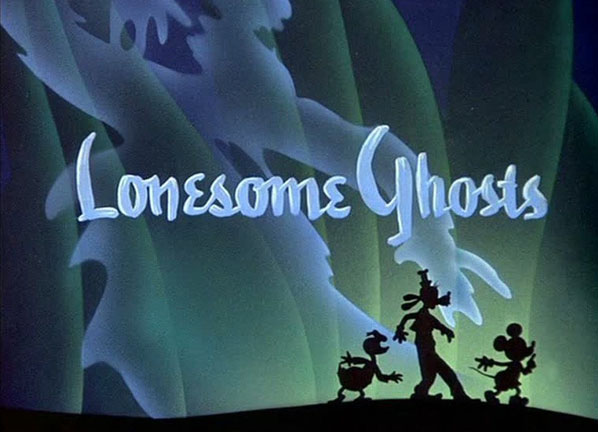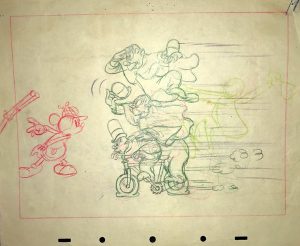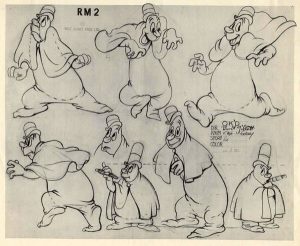 Suspended Animation #289
Suspended Animation #289
One of my favorite Disney theatrical shorts especially around this time of the year is Lonesome Ghosts (1937) that seemed to appear in every Halloween compilation that Disney ever put together for its television show.
In the 1930s and 1940s, American cinema was full of ghost chasers, ghost breakers, spook busters and more in comedy films starring Bob Hope, Abbott and Costello, the East Side Kids, the Three Stooges and more. So it was not that unusual for Disney to delve into the topic for a cartoon.
Lonesome Ghosts, which debuted on December 24th, 1937 just three days after the premiere of Walt Disney’s first full-length animated feature film, Snow White and the Seven Dwarfs was a co-starring vehicle for Mickey, Donald Duck and Goofy who were near the peak of their popularity.
That same year saw several other short cartoons that teamed the trio including Moose Hunters, Mickey’s Amateurs, Hawaiian Holiday and Clock Cleaners. The following year would include Boat Builders, Mickey’s Trailer, and The Whalers.
The seven minute short was directed by Burt Gillett and featured animation by Bob Wickersham, Clyde Geronimi, Dick Huemer, Milt Kahl, Art Babbitt and others. Gillett had joined the Disney Studio in 1929 and became one of its top directors helming both Flowers and Trees and Three Little Pigs.
As animation authority Steve Stanchfield has pointed out, “Burt Gillett must have had a hand in designing the ghosts in some capacity; they seem to have a kinship to some of the characters designed for Bold King Cole (that he had directed) over at Van Beuren a year before.”

Mickey, Donald and Goofy own the Ajax Ghost Exterminators business and are hired over the phone by a female voice to drive ghosts out of the McShiver mansion that is “full of ghosts”. Although the outside of their office has a sign saying “Busy”, the three are fast asleep when the phone rings. A sign behind Mickey states that “We chase ghosts by the day, week or month. Phone.”
Unknown to the heroes, they are being hired by four ghosts with bowler hats and bulbous noses who have gotten bored because no one comes around the abandoned house anymore and they wish to play their pranks. They are lonesome because no one visits.
They have seen the ad in the newspaper stating “Notice! We Exterminte All Kinds of Ghosts — Day and Night Service. Phone Gooseflesh 9000” and decide
to scare the pants off of the “wise guys” who placed the advertisement in the classified section.
When the trio arrives carrying a double barreled shotgun, net, axe, rope, chain, mousetrap and more, the front door falls down when Mickey knocks on it. As they step on the door, it unexpectedly flies up and throws them in to the house and they hear ghostly sounds. Mickey decides they will separate and surround the ghosts.
Mickey is knocked on the head. A ghost puts its finger in Mickey’s gun so it backfires and explodes. The ghost races upstairs and closes a door. Mickey tries to open the door and it falls down and ghosts playing a drum and fifes come marching out of it and go behind a set of double doors.
Mickey opens those doors and a wave of water floods out with ghosts surfing across it on surf boards. The last one comes out on a motorboat and circles Mickey until it and the water disappears completely.
 Donald is scared by a pile of dishes crashing behind him and then by a pile of chains thrown to the floor. He is whacked on his rear by a large board twice and then is mocked by a ghost imitating Donald’s fighting stance.
Donald is scared by a pile of dishes crashing behind him and then by a pile of chains thrown to the floor. He is whacked on his rear by a large board twice and then is mocked by a ghost imitating Donald’s fighting stance.
The ghost leaps into a pool of water on the floor and squirts Donald. The ghost then disappears along with the water and when Donald puts back on his hat, he finds it is filled with water that also disappears.
Holding an axe, Goofy is stalking a ghost but is frightened by a ghost banging a pan behind him and then playing a trombone behind him as Goofy tries to claw his way through a wall. Goofy chases the ghost into a set of dresser drawers and in the mirror on top of the dresser he and the ghost do a variation of the Marx Brothers’ famous mirror scene from Duck Soup (1933).
Goofy becomes entangled in the dresser and thinking he sees the ghost sticks a pin in his own rear end to the amusement of all four ghosts. They push the dresser with Goofy in it down the stairs. At the bottom of the stairs, the runaway dresser pushes Mickey, Donald and Goofy into barrels of molasses and flour.
As they struggle to free themselves from the goop, it makes them look like actual ghosts. That image frightens the four ghosts who rush through the house, breaking a window in the process and leaving their footprints in the snow outside as they run away. Donald laughs and calls them sissies.
One of the ghosts appears in the episode “When the Spirit Moves You” on the Bonkers television series where Bonkers and Miranda try to catch him. On House of Mouse, they appear in the episode “House Ghosts” where they scare Pete by pulling his underwear. They also appear in Mickey’s House of Villains during the hostile takeover.
 They appear in several videogames including Mickey Mania: The Timeless Adventures of Mickey Mouse, Mickey’s Wild Adventure, The Great Circus Mystery starring Mickey and Minnie, Disney Tsum Tsum, Search for the Secret Keys, Disney’s Magical Quest 2 Starring Mickey and Minnie and the Epic Mickey series (which features additional ghosts).
They appear in several videogames including Mickey Mania: The Timeless Adventures of Mickey Mouse, Mickey’s Wild Adventure, The Great Circus Mystery starring Mickey and Minnie, Disney Tsum Tsum, Search for the Secret Keys, Disney’s Magical Quest 2 Starring Mickey and Minnie and the Epic Mickey series (which features additional ghosts).
In 2009 the cartoon was shortened by approximately half its length for the Disney Have-a-Laugh series run on the Disney Channel.
Although unnamed in the original cartoon, the four ghosts have been given the names Jasper, Grubb, Boo and Moss. Jasper is considered the leader of the group and the smartest. Grubb is the smallest ghost and Billy Bletcher provides his voice. Boo is the one who scared Donald and Moss is the one who tormented Goofy.
It has always been assumed that the cartoon helped inspire the live action movie Ghostbusters (1984) since it has a group of ghost hunters and at one point Goofy proclaims “I ain’t a scared of no ghosts” which sounds like the phrase from the Ghostbusters theme song “I ain’t afraid of no ghosts”.
In the episode of the syndicated television series The Mouse Factory entitled “Spooks and Magic” that aired January 1972, at the end of the cartoon Lonesome Ghosts (1937) that week’s host comedienne Phyllis Diller frightens live-action Mickey, Donald and Goofy costumed as their characters from the short who are in her house.



 Jim Korkis is an internationally respected animation historian who in recent years has devoted his attention to the many worlds of Disney. He was a columnist for a variety of animation magazines. With his former writing partner, John Cawley, he authored several animation related books including The Encyclopedia of Cartoon Superstars, How to Create Animation, Cartoon Confidential and Get Animated’s Animation Art Buyer’s Guide. He taught animation classes at the Disney Institute in Florida as well as instructing classes on acting and animation history for Disney Feature Animation: Florida.
Jim Korkis is an internationally respected animation historian who in recent years has devoted his attention to the many worlds of Disney. He was a columnist for a variety of animation magazines. With his former writing partner, John Cawley, he authored several animation related books including The Encyclopedia of Cartoon Superstars, How to Create Animation, Cartoon Confidential and Get Animated’s Animation Art Buyer’s Guide. He taught animation classes at the Disney Institute in Florida as well as instructing classes on acting and animation history for Disney Feature Animation: Florida.




















































It must be getting close to Halloween — the stores are full of Christmas decorations!
The similarities between “Lonesome Ghosts” and the 1984 “Ghostbusters” film are certainly remarkable, but they strike me as no more than coincidental. Dan Aykroyd developed the “Ghostbusters” concept out of his family’s longstanding interest in the paranormal: his great-grandfather was a spiritualist who held seances in his house, and his father wrote a book about ghosts. The original treatment was much darker in tone than the finished movie, and the Ghostbusters only became a threesome after Harold Ramis was brought on board to revise Aykroyd’s script.
As for the song: director Ivan Reitman had set some montage sequences to the song “I Want a New Drug” by Huey Lewis and the News, with the intent of ultimately using an original song with the same feel and tempo. He asked Lewis to write the “Ghostbusters” theme, but Lewis declined. Ray Parker Jr. was then given the gig, with a deadline of only a few days; he found inspiration in a late night TV commercial for some service (“Who Ya Gonna Call?”). The song was so similar to “I Want a New Drug” that Lewis filed a lawsuit, which was later settled out of court.
It seems to me that “I ain’t scared of no ghosts!” is a fairly obvious setup line in any comedy about ghosts. Given the brief time frame that Parker had to work on the song, it’s a bit of a stretch to think that he might have seen, or been reminded of, “Lonesome Ghosts” just at that particular juncture.
Another similarity to “Ghostbusters” is that the Lonesome Ghosts are real. In the Bob Hope, Abbott and Costello, and Bowery Boys movies cited here, the ghosts are all hoaxes perpetrated by crooks.
I remember watching that Mouse Factory episode with my family. My mother, who could find a moral message in anything, said that “Lonesome Ghosts” proves the value of sticking together. After the exterminators decide to split up (“We’ll separate and surround them!”), the ghosts get the better of them; but when they stick together, with the help of some molasses and flour, they prevail.
“Lonesome Ghosts” was one of the film cartridges available for the Fisher-Price Movie Viewer in the 1970’s. From what I remember, it was the full, uncut cartoon; of course there was no sound, since all you did was hand-crank the film while watching through a single eyepiece lens. The great thing about hand-cranking it was I could go frame-by-frame and check out every pose and extreme take. It was especially interesting during the “open the door and the water floods out” scene to watch in slow-motion how the water swirled away and vanished .
Yes!! I had the same toy. I watched it so many times. Thanks for mentioning it:-)
I still have the Fisher Price movie viewer with this, the only cartridge I ever had for it. It is edited some from the original short. I also enjoyed the aspect of cranking it slowly and examining stills throughout. You could also crank it backwards and many scenes were even funnier that way. This and Clock Cleaners are my favorite two Disney shorts.
Speaking of “Mouse Factory”, has it ever been aired again or releases on home video? I have the first, yellow background 33rpm LP but have never seen the program.
“The Mouse Factory” was never released on home video. There were two record albums that tied in with the show, but neither were “soundtracks” per se, the 1968 version of “Minnie’s Yoo Hoo” that was used on both the DQ (yellow) album and the show’s closing titles was actually from a Wonderful World of Disney episode celebrating Mickey’s birthday.
Speaking of records, one of Jimmy Macdonald’s extended groans heard near the beginning of “Lonesome Ghosts” can be heard at the end of “The Haunted House” track on the classic Disneyland album Chilling, Thriling Sounds of the Haunted House (“Yewww are a BOLLLD and couragous person. Afraid of nothing.”0
Nice piece, Jim. I love the Disney cartoons from the 1935-40 period for their incredible animation, detail, design, music and other reasons. The only problem I have with this cartoon is that I find the echo on the ghosts’ voices a little too heavy to the point where it makes some of their dialogue hard to decipher. I wish Gillett had recognized this and just asked the sound department for the reverb to be a tad less…The ghost voices were Billy Bletcher (as you noted), Don Brodie as the gruff voiced one (Jasper?), Jack Bergman as the effeminate voiced ghost, and Harry Stanton as the mellow, deep ghost. Stanton and Bergman were character singers, Stanton being a marvelous basso who did Disney cartoons for years, up to Melody in 1953 (A life on the ocean wave…). Stanton’s biggest cartoon role was the singing narrator of MGM’s Abdul the Bulbul Ameer.
We are all eagerly awaiting a book by you on cartoon voice artists. I don’t know anyone else who has your extensive knowledge and expertise. Thanks for your additions here.
Are you the voice of Bullwinkle in that new Geico commercial that is currently running. This also gives me another chance to thank you for your help on expanding my knowledge on Count Cutelli and on your outstanding Jay Ward book.
I just picked up a reading copy of the 1962 Gold Key comic book Rocky and His Fiendish Friends #1 that I had when I was younger. It is the only comic book with artwork by Al Kilgore although he did write other issues. I wish someone would compile and reprint his Bullwinkle comic strip. I believe artist Jerry Robinson did the artwork for issue #2.
“Lonesome Ghosts” and other flashy ones like “Thru the Mirror” and “The Old Mill” must have cost more to produce than a straightforward Donald-and-nephews short. How did they budget individual cartoons? I’m guessing a few got extra dollars because they were experimenting with effects.
I’ve read that Warner gave each cartoon a fixed budget, and Chuck Jones gamed the system by knocking out a Road Runner ahead of schedule and having his team go to work on a more ambitious short, while time cards showed they were still working on Road Runner. Suspect that wouldn’t fly at Disney.
‘Lonesome Ghosts’ has always been one of my favorites. The sounds the ghosts emit fit so perfectly and the animation is done so well. I love the red noses. They help convey the ghosts as fun-loving tricksters…..nothing seriously frightening. I so enjoy seeing and hearing Mickey, Donald and Goofy in their classic forms. It’s the best.
The Fisher Price Movie Viewer toy (which I got second-hand in the 1980’s) was my first exposure to this cartoon. When Mickey, Donald, and Goofy split up, Donald’s section of the cartoon was edited out. I watched that version so many times as a kid that now when I see the full version my brain thinks the Donald section as “new”.
Coincidentally, yesterday Me-TV reran a “Beverly Hillbillies” Halloween episode called “The Ghost of Clampett Castle” from 1968. At one point Granny says, “I ain’t a-scared of no ghost.” That line sure did get around!
I also had the Fisher-Price movie projector, a hand-me-down 1970s toy I believe (back in the 80s). I remember this cartoon more from that toy cartridge. Frankly watching it one frame at a time, or even backwards, it almost made the film even more spooky to a little kid. It also allowed me to appreciate much of the intricacy and imaginative genius of the animation.
If it wasn’t for this new age of bringing classic Disney films onto emerging technologies; I think I would’ve forgotten this great era of animation. It brings fond memories, of finishing school to watch Disney reruns of this timeless era of film making. Mickey and friends have become engraved in many- sharing adventures.
With that being said it was only through this new technology called NFT’s (non fungible tokens) where I can say I own a time piece of Disney, so far a Donald Duck and Goofy. The rest of the Disney crew are also on the blockchain, the official ledger to record that Disney is on board with this new era. Only 4444 Goofy cards were made and I’m proud to say I own #1937, the year that brought me here. Now I can say I truly have become a historian of all sorts in finding about the pop culture of the 1930’s. Exciting times!
A snippet was used telling about New Year’s superstitions near the end of Disney’s Wonderful World of Winter 1983 educational short.